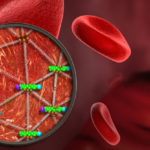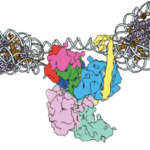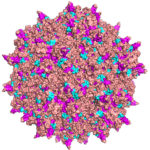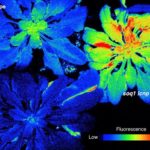Ke Xu, faculty scientist in the Molecular Biophysics and Integrated Bioimaging Division, used super-resolution microscopy to reveal the geodesic mesh supporting red blood cells, enabling them to be sturdy yet flexible enough to squeeze through narrow capillaries as they carry oxygen to tissues. The discovery could help uncover how malaria parasites hijack this mesh and destroy red blood cells. Read more at UC Berkeley News.
Silencing Is Golden: Scientists Image Molecules Vital for Gene Regulation
In two new studies, a team of researchers led by Eva Nogales, senior faculty scientist in the Molecular Biophysics and Integrated Bioimaging (MBIB) Division, has gained insight into the structure and function of molecules that act at the genetic level to give rise to different types of cells.
Doudna Honored by National Academy of Sciences
Jennifer Doudna, faculty scientist in the Molecular Biophysics & Integrated Bioimaging Division, UC Berkeley professor of chemistry and of molecular and cell biology, and Howard Hughes Medical Institute investigator, will receive the 2018 National Academy of Sciences (NAS) Award in Chemical Sciences. According to the NAS award announcement, Doudna is honored for her “pioneering discoveries on how RNA can fold to function in complex ways,” and her invention, with Emmanuelle Charpentier, of “the technology for efficient site-specific genome engineering using the CRISPR/Cas9 nucleases for genome editing — a breakthrough technology which has had an immediate and wide impact on all areas of both basic and applied life sciences.”
First Step Toward CRISPR Cure of Lou Gehrig’s Disease
For the first time, University of California, Berkeley scientists have used CRISPR-Cas9 gene editing to disable a defective gene that causes amyotrophic lateral sclerosis, or Lou Gehrig’s disease, in mice, extending their lifespan by 25 percent. The team was led by David Schaffer, faculty scientist in Molecular Biophysics and Integrated Bioimaging.
Biosciences Researchers ID Plant ‘Sunscreen’ Protein
A protein that protects plants from damage caused by too much light energy has been found by a team of researchers led by Kris Niyogi, faculty scientist in the Molecular Biophysics and Integrated Bioimaging Division. Alizée Malnoë, a postdoctoral researcher in Niyogi’s group, is the lead author on the study published in the journal The Plant Cell. Plants with deficient levels of the lipocalin protein are less able to dissipate excess light energy. Scientists will explore how this energy dissipation process is turned on and off, and whether manipulation of light usage could lead to higher crop yields. Read more in the Berkeley Lab News Center.
- « Previous Page
- 1
- …
- 47
- 48
- 49
- 50
- 51
- …
- 78
- Next Page »
Was this page useful?








